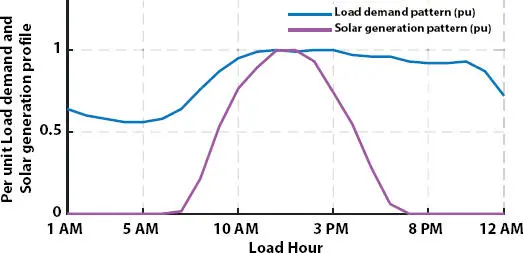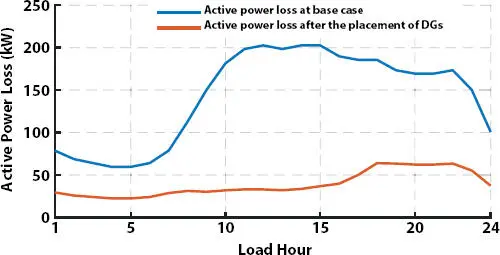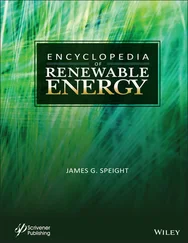The size of the solar PV can’t be varied. The installed capacity of solar PV is constant. So, the size of the solar PV has been optimized for a particular hour. In this study, the size of the solar PV has been optimized for the 15 thhour of the day correspond to which the load demand is 1.0 pu, and solar PV power generation is 0.7424 pu. The solar PV system generates and injects the active power to the distribution network. The active power injection from a solar PV plant for any particular hour can be expressed as in (Equation 1.33)
(1.33) 
where PV and solari are the solar PV installed capacity and solar power generation (in pu) for load hour of i . GF is the generation factor, having a value of (3.52/6.628) [68].
In this study, the biomass DG has been considered as the LPF DG having power factor being the same as the load demand. On the other hand, shunt capacitors available in the market are of standard size only. So, in this work, the sizes of shunt capacitors are considered to be as an integer multiple 25 kVAr. Table 1.5presents the cost of different DGs and their lifetime. Using the mixed discrete SPBO, the location of the biomass DG, solar PV, and shunt capacitor has been optimized. As the location of the installed plants can’t be moved from one bus to another bus, the locations of the considered DGs need to be kept constant.
Table 1.4 Variation of load demand (pu) and solar power generation (pu) with load hours.
| Load hour |
Load demand (pu)  |
Solar power generation (pu) [68] |
Load hour |
Load demand (pu)  |
Solar power generation (pu) [68] |
| 1 |
0.64 |
0 |
13 |
0.99 |
1 |
| 2 |
0.6 |
0 |
14 |
1 |
0.9309 |
| 3 |
0.58 |
0 |
15 |
1 |
0.7424 |
| 4 |
0.56 |
0 |
16 |
0.97 |
0.5491 |
| 5 |
0.56 |
0 |
17 |
0.96 |
0.2827 |
| 6 |
0.58 |
0 |
18 |
0.96 |
0.0593 |
| 7 |
0.64 |
0.015 |
19 |
0.93 |
0 |
| 8 |
0.76 |
0.2143 |
20 |
0.92 |
0 |
| 9 |
0.87 |
0.5331 |
21 |
0.92 |
0 |
| 10 |
0.95 |
0.7653 |
22 |
0.93 |
0 |
| 11 |
0.99 |
0.894 |
23 |
0.87 |
0 |
| 12 |
1 |
0.9968 |
24 |
0.72 |
0 |

Figure 1.2 Variation of load demand (pu) and solar power generation (pu) with load hour.
Table 1.5 Cost and lifetime of different DGs.
|
Biomass DG |
Solar PV |
Shunt capacitors |
| Cost ($) |
3000/kW [60] |
770/kW [60] |
9/kVAr |
| Lifetime (years) |
40 |
20 |
5 |
1.5.1 Optimum Placement of RDGs and Shunt Capacitors to 33-Bus Distribution Network
In this section, the optimum placement of biomass DG, solar PV, and shunt capacitors, to the 33-bus distribution network is discussed. Table 1.6presents the optimum sizes and locations of biomass DG, solar PV, and shunt capacitors for different load hours of the 33-bus distribution networks. The reductions of active power loss and VDI for different load hours have been shown in Figures 1.3and 1.4, respectively. From Table 1.6and Figure 1.3, it may be noticed that the active power loss reduction after the placement of biomass DG, solar PV, and shunt capacitor is quite significant for all the load hours. After the placement of RDGs and shunt capacitors to bus numbers 14, 31, and 30, respectively, the active power loss of the 33-bus distribution network reduces from 202.6771 kW to 36.8247 kW for the 15 thload hour. It may also be noticed that in presence of solar radiation, the active power loss reduction is higher compared to the same when the solar power generation is less or absent.
From Table 1.6and Figure 1.4, it may be noticed that the improvement of the voltage profile of the 33-bus distribution network is very good for all the load hours of the day. Improvement of the voltage profile of the distribution network leads to the reduction of VDI. From Table 1.6and Figure 1.4, the reduction of the VDI for all the load hours of the day may be noticed quite prominently. The voltage profile before and after the placement of DG to the 33-bus distribution network, for the 15 thload hour, has been presented in Figure 1.5.
Table 1.6 Optimum placement of RDGs and shunt capacitors to the 33-bus distribution network.
| Load hour |
Optimum size of biomass DG (kW) |
Optimum size of solar PV (kW) |
Optimum size of shunt capacitor (kVAr) |
Active power loss before placement of DG (kW) |
Active power loss after placement of DG (kW) |
Base VDI (before placement of DG) |
VDI after placement of DG |
| Location – 14 |
Location - 31 |
Location - 30 |
| 1 |
621.5083 |
1759.48 |
800 |
78.6548 |
29.4379 |
0.0453 |
0.0037 |
| 2 |
586.0025 |
1759.48 |
750 |
68.7376 |
25.8221 |
0.0396 |
0.0032 |
| 3 |
568.0646 |
1759.48 |
725 |
64.0501 |
24.1064 |
0.0369 |
0.003 |
| 4 |
550.005 |
1759.48 |
700 |
59.5413 |
22.4517 |
0.0343 |
0.0028 |
| 5 |
550.005 |
1759.48 |
700 |
59.5413 |
22.4517 |
0.0343 |
0.0028 |
| 6 |
568.0646 |
1759.48 |
725 |
64.0501 |
24.1064 |
0.0369 |
0.003 |
| 7 |
617.4665 |
1759.48 |
800 |
78.6548 |
28.7562 |
0.0453 |
0.0036 |
| 8 |
671.2714 |
1759.48 |
925 |
112.8660 |
31.2546 |
0.0651 |
0.0039 |
| 9 |
683.3 |
1759.48 |
1025 |
150.3564 |
30.2443 |
0.0868 |
0.0035 |
| 10 |
685.9 |
1759.48 |
1125 |
181.4934 |
31.9668 |
0.1048 |
0.0035 |
| 11 |
687.6 |
1759.48 |
1150 |
198.3321 |
33.0856 |
0.1146 |
0.0036 |
| 12 |
667.5 |
1759.48 |
1175 |
202.6771 |
32.981 |
0.1171 |
0.0033 |
| 13 |
661.5 |
1759.48 |
1150 |
198.3321 |
32.0711 |
0.1146 |
0.0032 |
| 14 |
683.7 |
1759.48 |
1175 |
202.6771 |
33.5922 |
0.1171 |
0.0035 |
| 15 |
730.9 |
1759.48 |
1175 |
202.6771 |
36.8247 |
0.1171 |
0.0043 |
| 16 |
752.1 |
1759.48 |
1175 |
189.8051 |
39.7576 |
0.1096 |
0.0048 |
| 17 |
812.9 |
1759.48 |
1175 |
185.6225 |
50 |
0.1072 |
0.0066 |
| 18 |
866.0 |
1759.48 |
1225 |
185.6225 |
63.9226 |
0.1072 |
0.0086 |
| 19 |
861.3 |
1759.48 |
1175 |
173.3949 |
63.4637 |
0.1001 |
0.0087 |
| 20 |
851.4 |
1759.48 |
1175 |
169.4248 |
62.2863 |
0.0978 |
0.0083 |
| 21 |
851.4 |
1759.48 |
1175 |
169.4248 |
62.2863 |
0.0978 |
0.0083 |
| 22 |
861.3 |
1759.48 |
1175 |
173.3949 |
63.4637 |
0.1001 |
0.0087 |
| 23 |
813.6 |
1759.48 |
1100 |
150.3564 |
55.3269 |
0.0868 |
0.0074 |
| 24 |
691.0056 |
1759.48 |
900 |
100.7052 |
37.4156 |
0.0580 |
0.0048 |

Читать дальше
















